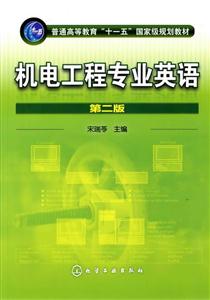機(jī)電工程專業(yè)英語-第二版 版權(quán)信息
- ISBN:9787122085672
- 條形碼:9787122085672 ; 978-7-122-08567-2
- 裝幀:暫無
- 冊(cè)數(shù):暫無
- 重量:暫無
- 所屬分類:>>
機(jī)電工程專業(yè)英語-第二版 本書特色
《機(jī)電工程專業(yè)英語(第2版)》:普通高等教育“十一五”國家級(jí)規(guī)劃教材
機(jī)電工程專業(yè)英語-第二版 內(nèi)容簡介
本書共分為8章,內(nèi)容包括制造導(dǎo)論、機(jī)械工程基礎(chǔ)、機(jī)械制造技術(shù)、電子及控制技術(shù)、數(shù)控技術(shù)、數(shù)控操作、現(xiàn)代制造技術(shù)、現(xiàn)代管理和互聯(lián)網(wǎng)及應(yīng)用等,每章含有課文正文、生詞詞組、難點(diǎn)注釋、理解練習(xí)、閱讀材料等部分,各章節(jié)內(nèi)容上彼此獨(dú)立,難度上循序漸進(jìn)。
本書內(nèi)容新穎,覆蓋面廣,且有一定的專業(yè)針對(duì)性和實(shí)用性。
本書的教學(xué)資料:包括ppt教學(xué)課件,詞匯測(cè)試系統(tǒng)等,是教師教學(xué)和學(xué)生學(xué)習(xí)的好幫手,并將免費(fèi)提供給采用本書作為教材的院校使用。如有需要,請(qǐng)發(fā)電子郵件至cipedu@163.com 獲取,或登錄www.cipedu.com.cn免費(fèi)下載。
本書可作為高職高專機(jī)械、機(jī)電、數(shù)控、工業(yè)工程及相關(guān)專業(yè)的教材,也可供工程技術(shù)人員參考。
機(jī)電工程專業(yè)英語-第二版 目錄
lesson 1 properties of materials
reading metals and alloys
lesson 2 classification of steels
reading machinability of metals
lesson 3 heat treatment
reading materials used for shafting
lesson 4 types of gear
reading cams
lesson 5 rolling-type (antifriction) bearings
reading clutch, rack and worm
chapter two technique of manufacturing engineering
lesson 1 mechanism of chip formation
reading cutting fluids and their importance
lesson 2 engine lathe
reading lathe work
lesson 3 the hydraulic system
reading hydraulic pumps
lesson 4 electric discharge machining
reading laser beam machining
lesson 5 benefits of a quality system
reading introduction to iso 9000 basics
chapter three electronics technology and automation
lesson 1 types of integrated circuits
reading optoelectronics
lesson 2 printed circuit
reading repair of printed circuit
lesson 3 alternating-current motors
reading motor& motor care and maintenance
lesson 4 interfacing
reading a/d&d/a converter
lesson 5 controllers
reading guidelines for designing a plc system
chapter four cnc machines
lesson 1 the fundamentals of cnc
reading the concepts of computer numerical control
lesson 2 types of cnc machines
reading laser cutting
lesson 3 the cnc control
reading components of cnc machine
lesson 4 methods for cnc programming
reading manual programming
lesson 5 cad/cam
reading cad/ cam integration
chapter five cnc machine operating
lesson 1 explanation of the keyboard
reading fanuc—besk nc system
lesson 2 tilting nc-rotary table
reading employment opportunities in nc
lesson 3 handling and operation
reading chart
lesson 4 failures and breakdowns
reading position detectors- opto-electronical rotary encoders
lesson 5 service and maintenance
reading error search and repair
chapter six modern manufacturing technology
lesson 1 flexible manufacturing systems
reading robotics
lesson 2 expert systems
reading decision support systems
lesson 3 computer aided process planning
reading artificial intelligence & expert system
lesson 4 rapid prototyping and freeform fabrication
reading stereolithography
lesson 5 from the present to the future
reading aesthetics in design
chapter seven modern management
chapter eight computer and application
references
機(jī)電工程專業(yè)英語-第二版 節(jié)選
《機(jī)電工程專業(yè)英語(第2版)》共分為8章,內(nèi)容包括制造導(dǎo)論、機(jī)械工程基礎(chǔ)、機(jī)械制造技術(shù)、電子及控制技術(shù)、數(shù)控技術(shù)、數(shù)控操作、現(xiàn)代制造技術(shù)、現(xiàn)代管理和互聯(lián)網(wǎng)及應(yīng)用等,每章含有課文正文、生詞詞組、難點(diǎn)注釋、理解練習(xí)、閱讀材料等部分,各章節(jié)內(nèi)容上彼此獨(dú)立,難度上循序漸進(jìn)。 《機(jī)電工程專業(yè)英語(第2版)》內(nèi)容新穎,覆蓋面廣,且有一定的專業(yè)針對(duì)性和實(shí)用性。 《機(jī)電工程專業(yè)英語(第2版)》可作為高職高專機(jī)械、機(jī)電、數(shù)控、工業(yè)工程及相關(guān)專業(yè)的教材,也可供工程技術(shù)人員參考。
機(jī)電工程專業(yè)英語-第二版 相關(guān)資料
插圖:Thus the cooling properties of cutting fluid depend to a large extent on thecooling method. The cooling efficiency increases with heat conductivity and specificheat of the cutting fluid, with its heat of fusion and of vaporization, and also with itsviscosity. Cooling effect increases, too, with the flow rate of the fluid, the area ofapplication and with decreasing temperature of the cutting fluid.The lubricating action of the cutting fluid reduces the external friction betweenrake face and chip and between flank and machined surface~. Effectiveness of thelubricating action depends, therefore, in the first place on the degree of penetration ofthe coolant between those surfaces. It follows from the magnitude of specific cuttingforces that very often, i.e. when machining steel, pressures between chip and toolpoint and between workpiece and tool point may reach 20000~30000 kg/cm2. Notwithstanding such high pressures, the use of suitable cutting fluids results in thereduction of friction and wear.The washing action of a cutting fluid consists in removing the products ofabrasion, chip fragments and tool wear particle. In practice, cutting fluids exhibitgood washing properties having high wettability and because particles immersed inthe liquid move downstream.This action has an advantageous influence on the smoothness of the machinedsurface and on the reduction of tool point wear.Surface loosening action of the cutting fluid, also called the cutting action of thisfluid, results from the so-called Rebinder effect. Adsorbed molecules of cutting fluid,particularly of liquids containing surface-active additives, disintegrate, diffuse andpenetrate into microgaps resulting from defects in the crystal lattice. Because of thewedge-like action of the adsorbed liquid, a very thin surface layer of the machinedmaterial becomes "loosened".According to Rebinder's research, the thickness of this layer may reach 0.1 mm.Since the machined surface in the next pass becomes the work surface, plasticdeformation appearing in the chip formation area and slip of the chip elements occurmore easily and more frequently. This phenomenon is called internal lubrication.The efficiency of activated liquids increases with a reduction in unreformedchip thickness, since in this case the percentage share of the thickness of loosed layer is greater in relation to the total thickness.Increasing the cutting speed decreases the efficiency of activated liquids. This is due to a more ductile chip, having a much smaller number of larger gaps of all sorts (lack of preceding gap and of built-up edge). Consequently, much fewer local vacuum spots are formed and the liquid does not penetrate everywhere, and dry friction may result.
- >
李白與唐代文化
- >
小考拉的故事-套裝共3冊(cè)
- >
人文閱讀與收藏·良友文學(xué)叢書:一天的工作
- >
苦雨齋序跋文-周作人自編集
- >
羅曼·羅蘭讀書隨筆-精裝
- >
上帝之肋:男人的真實(shí)旅程
- >
推拿
- >
大紅狗在馬戲團(tuán)-大紅狗克里弗-助人




















